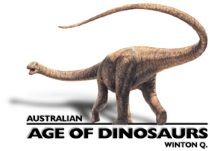SUSTAINABILITY
 The Museum has worked tirelessly for many years to become socially, economically and environmentally sustainable. The benefits of embedding a culture of sustainable practice throughout the Museum are threefold:
The Museum has worked tirelessly for many years to become socially, economically and environmentally sustainable. The benefits of embedding a culture of sustainable practice throughout the Museum are threefold:
1) create a self-sufficient business focused on Australian natural history in Central West Queensland, marketed through the promotion of palaeo-tourism, astro-tourism and ecotourism
2) instigate economic growth and development in very remote Australia and
3) meet the Museum’s current needs without compromising the social, economic or environmental sustainment of future generations.
While the Museum is still developing, sustainable practices have already begun and are included in the Museum's future plans.
To meet its current needs without compromising environmental sustainment, the Museum is committed to environmental protection and enhancement. Internally, this means that the Museum embraces the best practices of environmental management techniques, such as total quality management, continuous improvement, motivating and empowering people, international benchmarking, social responsibility and environmental awareness. The latter is achieved through:
• The Dinosaur to Dunnarts program
During Museum’s tours of The Jump-Up visitors are informed about the Dinosaurs to Dunnarts program, a biodiversity program established by the Museum in 2009. This program encourages staff, visitors and volunteers to take photos of the flora and fauna they encounter on The Jump-Up and send the images to the Museum for identification.
• Promoting environmentally responsible practices
The Museum employs an array of different methods to reduce carbon emissions and promote environmentally responsible practices to the public. These methods include incorporating a Museum-wide recycling program to collect bottles and cans to transport to the Longreach and Winton Containers for Change centres. The cash from these recycled items is donated to a local community group, nominated by staff and volunteers each year. Other ethically responsible practices include purchasing biodegradable material in the Cretaceous Café and Museum Shop, purchasing tour materials that can be reused (notebooks and pencils), encouraging visitors to leave their pets in Museum-provided kennels while on tour and asking visitors to take all waste material brought to The Jump-Up away with them.
• Infrastructure that captures the essence of an ancient landscape
The public buildings on The Jump-Up have been designed to fit seamlessly into the environment around them. These buildings on The Jump-Up appear to taper down into the cap rock through the use of multiple interlocking precast concrete panels and hand-made perforated iron sheets. Designed by Cox Architecture (formerly Cox Rayner Architects), the Reception Centre and Dinosaur Canyon Outpost are the first of several planned buildings that have been inspired by the mesa’s deep rock fissures and deep earthy colour scheme.
Our commitment to reducing our emissions - We are proud to participate in the Tourism Emissions Reduction Program. This initiative underscores our commitment to reducing our environmental impact and promoting sustainable practices. Initially, our emissions estimate included basic elements like water, fuel, energy and general waste. Our latest estimate now encompasses a broader range of categories, such as business travel, employee commute and suppliers, providing a more detailed understanding of our emissions. Explore our comprehensive Tourism Emissions Reduction Plan to see how we're taking actionable steps towards a greener future.
View our Emission Reduce Plan by clicking here.

